Khi nói đến ước lượng agile, bạn không thể không đề cập đến các nguyên tắc cơ bản của nó: sử dụng đơn vị ước lượng tương đối (như điểm câu chuyện), thúc đẩy thảo luận chi tiết về nội dung của các user stories, hình thành sự đồng thuận và cam kết với giải pháp, và nâng cao đội ngũ thông qua sự hợp tác gắn kết.
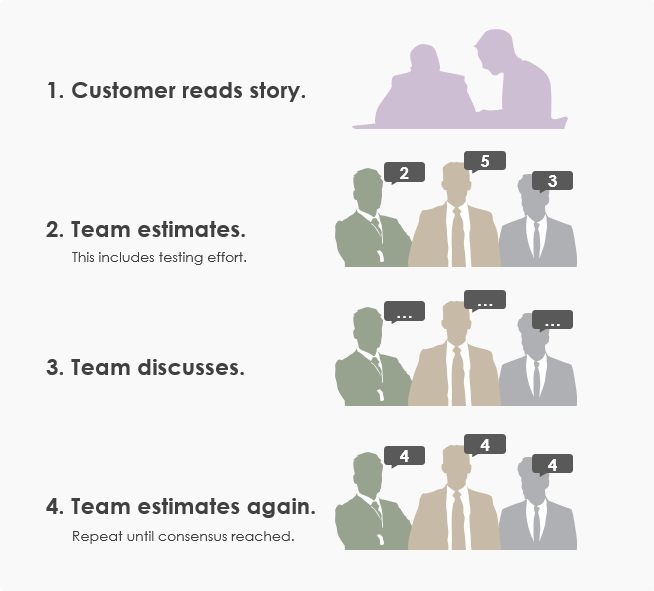
Nhiều đội agile xung quanh tôi sử dụng “planning poker” để ước lượng điểm câu chuyện. Mặc dù phương pháp này phổ biến, nhưng nó cũng có những hạn chế.
Ví dụ:
- Chức năng cần ước lượng quá lớn, và không dễ để ước lượng bằng “planning poker”;
- Có 300 câu chuyện xuất hiện;
- User story cần ước lượng không có đủ thông tin để tham khảo;
- Thời gian gấp rút, không có thời gian để ước lượng toàn bộ danh sách nhu cầu sản phẩm.
Vì vậy, bài viết này không chỉ giới thiệu phương pháp ước lượng agile phổ biến nhất “planning poker”, mà còn 6 phương pháp ước lượng agile khác phù hợp với tất cả nhu cầu của bạn cho việc ước lượng user story.
1. Planning Poker
Tất cả các thành viên tham gia sử dụng thẻ bài có số để ước lượng câu chuyện của người dùng, bỏ phiếu ẩn danh khi ước lượng, thảo luận nếu có sự bất đồng lớn, và sau đó bỏ phiếu lại, cho đến khi toàn đội đạt được sự đồng thuận về độ chính xác của ước lượng. Việc sử dụng planning poker có những hạn chế và phù hợp nhất cho các đội nhỏ (5–8 người) và một số lượng nhỏ user stories (tối đa 10).
Mẹo:Mặc dù không phải là quy tắc, nhưng rất được khuyến nghị để chia nhỏ các user stories trong danh sách tồn đọng sản phẩm không lớn hơn 13 điểm; để đội của bạn có thể hiểu rõ các user stories đến mức độ chi tiết có thể ước lượng một cách thoải mái.
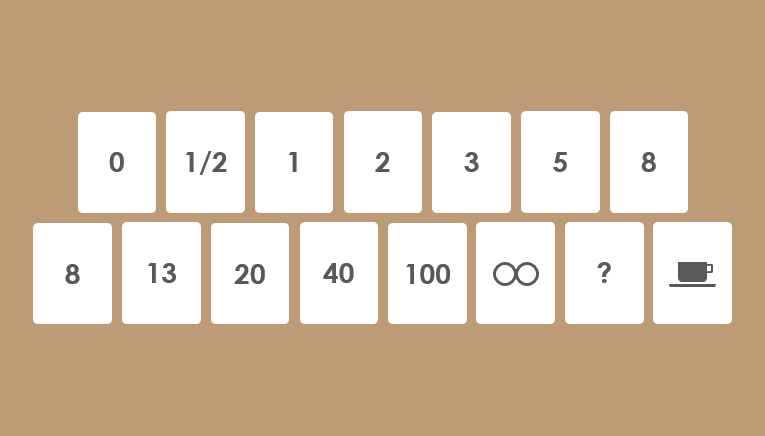
2. Kích thước áo phông
Sử dụng kích thước áo phông để ước lượng kích thước của câu chuyện người dùng: XS, S, M, L, XL. Kích thước của mỗi loại đại diện cho nhu cầu thảo luận cởi mở và trung thực. Phương pháp này nhanh chóng và dễ dàng, và bạn có thể ước lượng kích thước của danh sách nhu cầu sản phẩm một cách táo bạo.
Mẹo:Phương pháp này phù hợp để ước lượng danh sách nhu cầu lớn của các user stories lớn, đặc biệt khi nhiều đội Scrum làm việc xung quanh một sản phẩm.
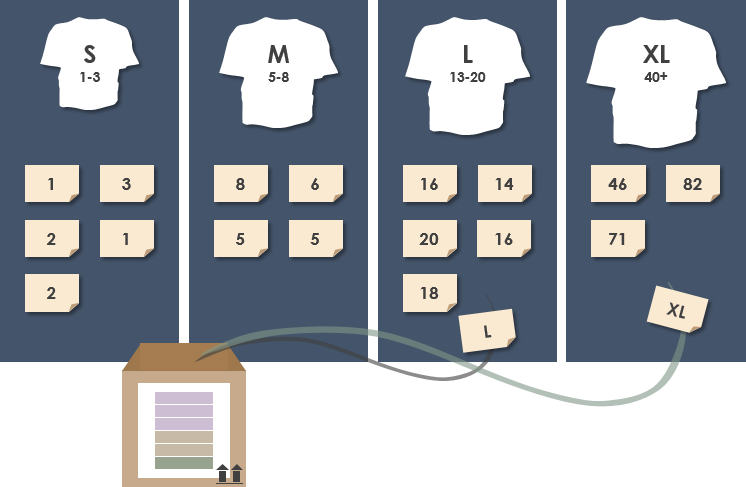
3. Bỏ phiếu chấm
Phương pháp này phù hợp để ước lượng các user stories nhỏ, và phương pháp này rất đơn giản và hiệu quả. “Bỏ phiếu chấm” là một cách để đưa ra quyết định, nhưng bạn cũng có thể sử dụng nó để ước lượng các user stories. Phương pháp là: mỗi người được phân công một vài tờ giấy ghi chú, tự do chọn các user stories để bỏ phiếu. Càng nhiều chấm mà một user story nhận được, nó càng đại diện cho nhiều khối lượng.
Mẹo:Phương pháp này có thể được sử dụng trong cả đội lớn và nhỏ, nhưng bạn phải giới hạn số lượng user stories được ước lượng.
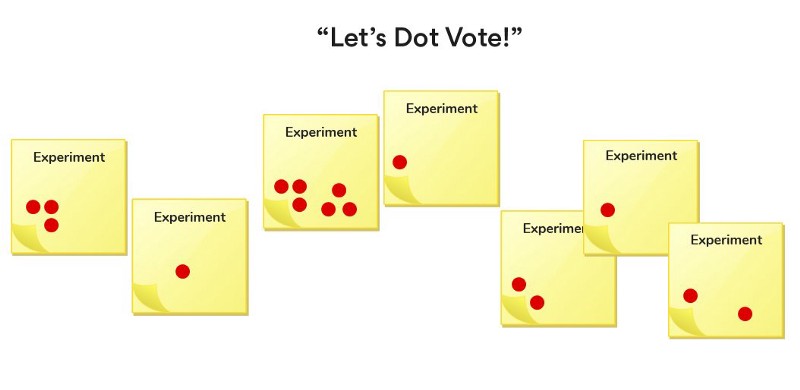
4. Hệ Thống Xô
Giả sử bạn có một số lượng lớn user stories cần được ước lượng, và bạn muốn tăng tốc toàn bộ quá trình. Thực tế, bạn đang tìm kiếm một ước lượng hiệu quả hơn so với planning poker, thì “hệ thống xô” có thể là một lựa chọn mong muốn.
Đầu tiên, thiết lập một vài “xô” theo thứ tự tuần tự của “thẻ planning poker”. Sau đó, đội viết user story cần ước lượng lên tờ giấy ghi chú và cho vào ước lượng “xô”.
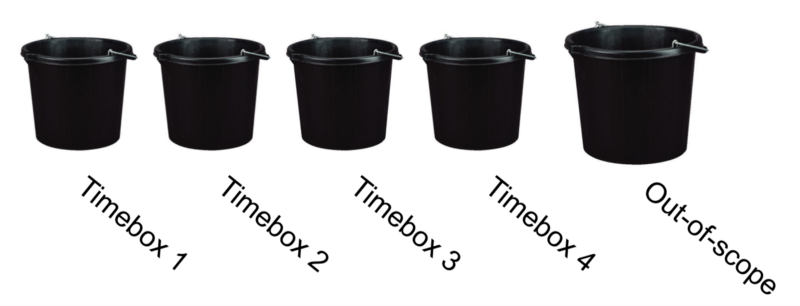
3. Phương Pháp Ba Điểm
Ước lượng 3 điểm thuộc lĩnh vực kiến thức quản lý thời gian. Nó cũng có thể được sử dụng trong ước lượng chi phí. Vấn đề với các ước lượng điểm đơn là chúng hiếm khi chính xác. Một ước lượng ba điểm là một ước lượng tốt hơn, so với một ước lượng điểm đơn.
Ước lượng điểm đơn chỉ đơn giản cho bạn một số duy nhất — ví dụ,
Phát triển:Mất bao lâu để hoàn thành tính năng quy trình đặt hàng?
Độ tin cậy của ước lượng này là bao nhiêu5 ngàyước lượng? Nó sẽ phụ thuộc vào nhà phát triển, và liệu nhiệm vụ này đã được thực hiện trước đó hay chưa? Nếu đó là một nhiệm vụ thường xuyên, và đã được thực hiện nhiều lần, thì ước lượng điểm đơn có thể là cách đi. Nhưng nếu đó là một điều chưa bao giờ thực hiện, hoặc là một hoạt động mới, hoặc kỹ sư mới với hoạt động này, thì con số này có thể không chính xác. Trong những trường hợp như vậy, việc chọn ước lượng ba điểm sẽ mang lại cho bạn độ tin cậy cao hơn.
Ước lượng ba điểm xem xét ước lượng lạc quan nhất (O), ước lượng có khả năng xảy ra nhất (M), và ước lượng bi quan (ước lượng ít khả năng xảy ra nhất) hoặc (L).
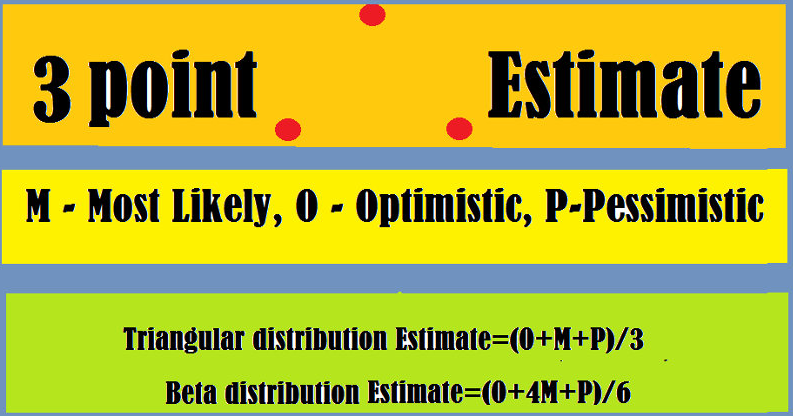
6. Ước Lượng Affinity
Ước lượng affinity là tìm kiếm sự tương đồng của các user stories cần được ước lượng. Nhiệm vụ của đội là nhóm các user stories tương tự. Cách tốt nhất để “tìm sự tương đồng” là hình dung quá trình và kết hợp các tổng phụ thành các nhóm lớn.

Mẹo:Phương pháp này hoạt động tốt nhất trong một nhóm nhỏ người và một số lượng nhỏ user stories, bạn phải phân công các ước lượng khác nhau cho các nhóm khác nhau.
7. Phương Pháp Sắp Xếp
Cách tiếp cận này cho phép bạn có một đánh giá tương đối chính xác về kích thước tương đối của câu chuyện người dùng. Nếu một nhóm nhỏ các chuyên gia thực hiện điều này, nó sẽ hoạt động tốt nhất.
Dưới đây là cách thực hiện: Đặt tất cả các user stories trên một nhãn đánh dấu từ thấp đến cao theo bất kỳ thứ tự nào, và mỗi người tham gia có thể di chuyển một user story trên thang đo, chỉ di chuyển một khung thấp hoặc cao cho mỗi lần di chuyển. Hoặc bỏ qua một vòng. Lặp lại quá trình này cho đến khi tất cả các thành viên trong đội không muốn di chuyển user story hoặc bỏ qua một vòng.

Mẹo:Phương pháp sắp xếp này có thể đạt được một ước lượng kích thước chi tiết, phù hợp cho các nhóm nhỏ người và một số lượng lớn user stories.
Tóm tắt
Mục đích của bài viết này là giới thiệu cho bạn sự tồn tại của những phương pháp này. Trước khi sử dụng hàng ngày, bạn nên thử nghiệm các phương pháp khác nhau dựa trên câu chuyện người dùng của riêng bạn và quy mô nhân viên của bạn.
Nếu bạn quan tâm đến những phương pháp này, vui lòng để lại tin nhắn trong phần bình luận. Tôi có thể giải thích chi tiết hơn về phương pháp trong một bài viết riêng.
Các bài viết khác về Kỹ thuật và Tài liệu Scrum
- Tài liệu Scrum là gì?
- Định nghĩa hoàn thành và Tiêu chí chấp nhận
- Định nghĩa sẵn sàng trong Scrum là gì?
- Làm thế nào để viết mục tiêu Sprint?
- Product Backlog trong Scrum là gì? Ai chịu trách nhiệm về nó?
- Làm thế nào để tinh chỉnh Product Backlog?
- Sprint Backlog trong Scrum là gì?
- Làm thế nào để ưu tiên Product Backlog bằng phương pháp MoSCoW
- Làm thế nào để ưu tiên Product Backlog bằng phương pháp 100 điểm?
- Mục tiêu Sprint trong Scrum là gì?
- Biểu đồ Burndown trong Scrum là gì?
- Mẫu Vai trò-Tính năng-Lý do là gì?
- Tăng Sprint so với Sản phẩm có thể giao hàng tiềm năng so với MVP và MMP
- Viết mục tiêu SMART & INVEST cho các câu chuyện người dùng
- DEEP trong Product Backlog là gì?
- Làm thế nào để viết tầm nhìn sản phẩm cho dự án Scrum?
- Làm thế nào để sử dụng bảng Scrum cho phát triển Agile?
- Ai tạo các mục Product Backlog hoặc câu chuyện người dùng trong Scrum?
- Ước lượng Agile là gì?
- Điểm câu chuyện trong Agile là gì? Làm thế nào để ước lượng một câu chuyện người dùng?
This post is also available in Deutsch, English, Español, فارسی, Français, Bahasa Indonesia, 日本語, Polski, Portuguese, Ру́сский, 简体中文 and 繁體中文.













